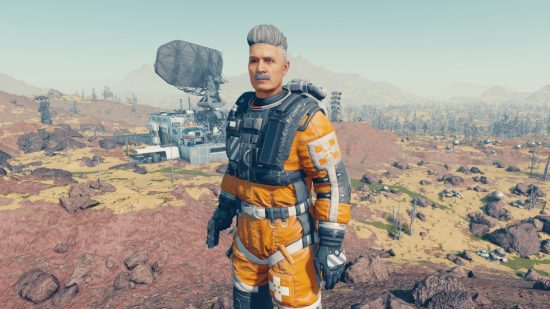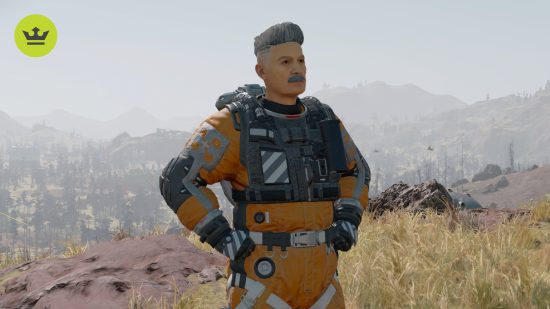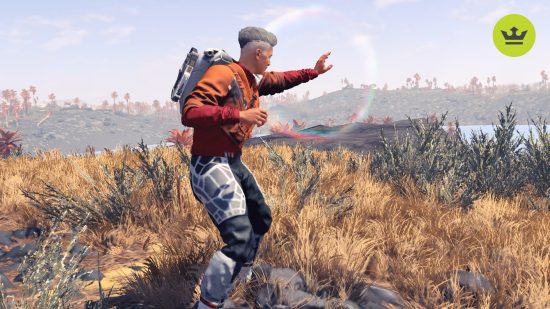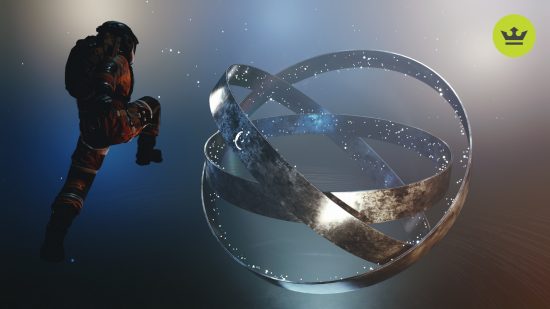Our Verdict
While it has weak spots and doesn't push many boundaries, Starfield is still an excellent RPG experience. Bethesda has once again mastered the things it built its reputation on - world building, quest design, and deep customization. However, it's found new things to excel at too, with exciting combat and a novel implementation of New Game Plus.
October 13, 2023 Our review of Starfield has now been completed and scored after more than 100 hours of gameplay.
A thousand planets, hundreds of thousands of voice lines, ship and outpost building, spaceship dogfights, jetpacks, flora and fauna to document, resource mining, and a central narrative that looks to answer a simple yet poignant question: ‘what’s out there?’ It’s safe to say that there’s a lot of ground to cover in our Starfield review. So, after over 110 hours of gameplay on the Xbox Series S, does 2023’s most hyped game live up to expectations? Well, despite a slightly tedious and mediocre opening few hours, Starfield finally fires up its rocket boosters and sets a course for our best RPGs list – but it isn’t exactly the genre-redefining game many, including myself, thought it would be.
I begin with a warning about first impressions – Starfield takes a while to get going and is hard to appreciate at first. Despite the hype around this potentially being one of the best Xbox games of this generation, your opening three or four hours will, most-likely, feel underwhelming. There is little narrative build-up or weight to you joining Constellation, the main Starfield faction of space explorers wanting to locate mysterious Artifacts scattered throughout Starfield’s universe. The first ship you get, and the introduction to space flight, is frustrating. The menus – particularly the Starfield map showing you all the systems and locations – will bamboozle you.
It’s surprising that Starfield starts this poorly and that the user experience is this complicated, given how much of an opportunity Bethesda has to attract new players to its games thanks to Starfield launching on Game Pass (and the huge marketing push it received before launch as well). However, things will get easier, and as everything begins to open up, Starfield starts to feel a lot more like the game it was billed to be.

The main carrot that Bethesda dangled in front of gamers before launch was the prospect of traversing over a thousand Starfield planets. This was the hyper-ambitious crux of the game, letting players loose in an enormous galaxy filled with a mixture of hand-crafted and procedurally-generated content, with spaceflight and grav jumping carrying you between each star, planet, moon, or space station. Much to my surprise, it turns out that space travel is actually the most boring and forgettable part about Starfield – luckily, things massively improve when you actually reach your destination.
When your boots are on the ground, Starfield really sings. I’ve been impressed by how many hand-crafted locations there are, how many of them feel very distinct and memorable, and how crammed with content they are too. The Starfield cities – and even some of the smaller towns, settlements, and space stations – are a joy to explore. NPCs, vendors, and environmental storytelling are everywhere you look in these areas – Bethesda’s renowned for its worldbuilding, and it has once again excelled at this in Starfield.
When venturing out beyond main settlements and locations, smaller points of interest like abandoned research facilities, caves, or natural features will initially lure you in and convince you to go exploring. I will concede though that these get repetitive very quickly. While Bethesda made no bones about these small locations not being hand-crafted before launch, I didn’t expect there to be such little variance between them. Nevertheless, they function as useful places to either farm Starfield XP or to get excellent rewards. The rather annoying oxygen system does put up a bit of an unnecessary barrier to planetary exploration, so I recommend investing skill points and wearing gear that will increase your O2 regeneration.
Starfield’s slick and enjoyable combat has also impressed me. Combat is often an afterthought for Bethesda RPGs, but not here. The variety of Starfield weapons, and how good they all feel, has been a pleasant surprise, and fights with human, robot, or alien foes feel extra fun when movement mechanics like sliding and the boost pack come into play. Starfield powers add another layer to encounters, and while some are a bit underpowered or too situational, there are plenty of strong options that really make you feel, well, powerful. Stealth can also be a viable approach, but it will require you invest your skill points wisely, attach the right mods to weapons, and wear gear with the Chameleon trait, which can allow you to go invisible.
As I alluded to earlier, though, the off-planet experience is nowhere near as fleshed out, memorable, or engaging as the on-planet action. The vistas out of your cockpit window occasionally provide a ‘wow’ moment if you’ve got a particularly pretty planet in front of you, but that’s pretty much it. Ship combat really isn’t as fun and as fleshed out as I’d hoped, and it will definitely feel that way for the majority of players in the opening 10-30 hours of the game, depending on how long it takes you to get one of the best Starfield ships. Once you invest in either a better ship or upgrade a decent one you’ve already got, dogfights still don’t really get any more exciting. Easier, sure, but enjoyable? Not really.
What irks me the most about ships though is how grav jumping and spaceflight in general is nothing more than contextualization for what is essentially a fast travel system, and you don’t even have to be in your ship to benefit from fast traveling most of the time either. In my playthrough, my ship has basically served as a place to stash loot and resources. I’ve found myself wanting to spend as little time in the cockpit as possible, and simply want the quickest route to the next boots-on-the-ground location.
What about the RPG elements then? The refined, upgradeable skill system finds the perfect sweet spot between being too simplistic and over-complicated, so zero complaints there. Background traits help flesh out your character right from the get-go and are not just freebies – there is a risk-reward consideration to make for all of them. Dialogue options allow for a decent level of expression. The Starfield character creator gives you a huge amount of choice when it comes to appearance, and it’s very easy to change your appearance in Starfield as well at a later date. So, as you can see, there’s plenty of freedom to go about crafting your own story.
However, your hurried introduction and recruitment to Constellation right at the start of the game does come across as a bit jarring if you’re trying to play as a more rebellious or evil character. If you want your Starfield character to be a wannabe space explorer or general do-gooder, then I can imagine this is no problem. For those who wanted to play the game as more of a blunt, battle-scarred mercenary (as I wanted to), the rather upbeat, starry-eyed start to the game does make your character’s backstory seem a little redundant.
This is exacerbated by the main Starfield companions too – while there is some nuance to each of them, they are all Constellation members, and as a result all but one of them (Andreja) frown upon pretty much anything that is morally grey.
For the most part, the main questline pretty much forces you to be the good guy and to fit into Constellation’s agenda, which did frustrate me for the first 15 hours or so. However, some narrative curveballs and the incentive of finding more artifacts (and therefore adding more powers to your arsenal) made me more than compelled to carry on. While I do wish there was a bit more narrative freedom here, the main questline is still a very enjoyable play, and having recently wrapped it up, I can say that it ends in a slightly predictable but still poignant and satisfying way that cleverly feeds into Starfield New Game Plus – more on that in just a moment.
Outside of the gaze of Constellation, Starfield does become somewhat more flexible and lets you play your way. Faction quests, companion quests, and side quests have regularly pulled me away from the main storyline and have mostly been brilliant. In typical Bethesda fashion, these introduce you to interesting characters and take you to places you probably wouldn’t have otherwise found in Starfied’s sprawling galaxy. If you want to flex your bad guy muscles away from the gaze of the morally righteous Constellation, I encourage you to leap into the Crimson Fleet and Ryujin Industries faction quests – while the latter starts rather slowly, the former is an excellent questline, but both are there to satiate players that want to tear up the Settled Systems’ rulebook.
Now we’re going to touch on New Game Plus in Starfield – one of the game’s biggest mysteries before launch, and one of its biggest talking points afterwards.
After about 60 hours – during which I finished the main story, mopped up all the faction quests, completed a couple of companion quests and about 20 side quests, and did a few hours of planetary exploration – I took the leap into New Game Plus. I enjoyed the transition between my original playthrough and NG+, and hats off to Bethesda for weaving this mechanic into the narrative, rather than simply sending you back to the main menu and saying: ‘Go on then, try it all again with beefier enemies this time’ like most games.
However, I immediately regretted my decision, and wished that I’d committed more time completing quests and doing more exploration as my initial character, without the… knowledge… I now possessed. I urge you to only give into the temptation of NG+ once you’re convinced you’ve get nothing left to eek out of your current character, quest-wise.
Don’t get me wrong, New Game Plus is fun, and I really love the subtle differences and unique dialog options that open up for you. You also have the option to not divulge said knowledge to people in your new playthrough if you don’t want to. On my first NG+, I decided to spill the beans immediately, just so I could blast through the main Constellation story again to see a different outcome. I’m now on my second NG+, and I’m playing dumb this time around. I’m taking much more time, seeing how different choices effect faction and companion questlines.
While I can’t claim to have spent enormous amounts of time with these systems yet, a quick word on ship building and outposts. Ship building is fiddly but really quite fun, although I very rarely did this out of recreational choice – a lot of the time, the need for better weapons or more cargo space forced my hand, but I can see how some players would get lost in this. Meanwhile, outposts have already started to grip me in the same way Fallout 4’s settlements did. Finding the best Starfield outpost locations is a fun, exploratory task, while stitching all the components together on your newly-claimed section of outer space feels super satisfying and therapeutic. Unlike some other UI elements in Starfield, which we’ll discuss in a moment, I’ve found the process of constructing outposts surprisingly intuitive.
So that’s the creative side of Starfield pretty much covered, but what about some of the fundamentals like user experience and performance?
While you do get used to it after maybe 30-40 hours, Starfield does suffer from some UX issues. I am envious of the PC players that can already tap into Starfield mods to improve some truly bizarre menu choices from Bethesda. I also can’t get over the fact there are no detailed city maps – I’m not sure how Bethesda can hype up New Atlantis as the biggest city its ever built, and then simply not tell you where everything is. Luckily, our friends at StarfieldDB have you sorted with their own handy New Atlantis map. Vendor and cargo menus also always catch me out as well – the handy side-by-side menus of Fallout 4 have been banished for single-pane ones, and I can’t tell you how many times I’ve accidentally sold something I thought I was buying, or transferred something to my character I thought I was depositing in my ship’s cargo hold.
It’s also important to talk about Starfield’s performance on console. One big concern I had before hopping into Starfield was that I would be playing this enormous, demanding RPG on my Xbox Series S. Generally, the small but mighty console has done a fairly decent job. However, I’ve had some frame rate drops and stutters in content-packed areas like Neon or Akila City. I also encourage everyone to quick save regularly, as in my roughly 110 hours of game time, I’ve had probably around 25 crashes or freezes that have sent me back to Xbox dashboard. I imagine this is more a Starfield problem than a Series S problem, but judging by my experience, you’ll be lucky to get through Starfield without at least a few of these moments.
While these are frustrating chinks in Starfield’s armor, I can’t stay mad at them for long. For every sigh-inducing moment Starfield throws up, you’ll get a dozen that make you smile in return.
Overall, I’ve been really enjoying Starfield. But as you can tell, it’s far from perfect. Promises of epic dogfights and traversing the universe in your ship haven’t been fully realized, the user experience is surprisingly clunky, and there have been some performance hiccups. Nevertheless, I’ve once again been completely hooked by Bethesda’s world-building, Starfield’s boots-on-the-ground combat, and the staggering amount of hand-crafted content in this game.
Despite its size and scope, any pre-release predictions and hopes that it would be a genre and generation-defining game are, sadly, wide of the mark. However, Starfield is still a brilliant game, and Bethesda’s galaxy is one I’ll be getting lost in for many months and years to come.
Still looking for more? While a good Starfield wiki can be a handy source of information, our new Starfield Database goes further, offering you daily news, searchable databanks, and even interactive tools.






